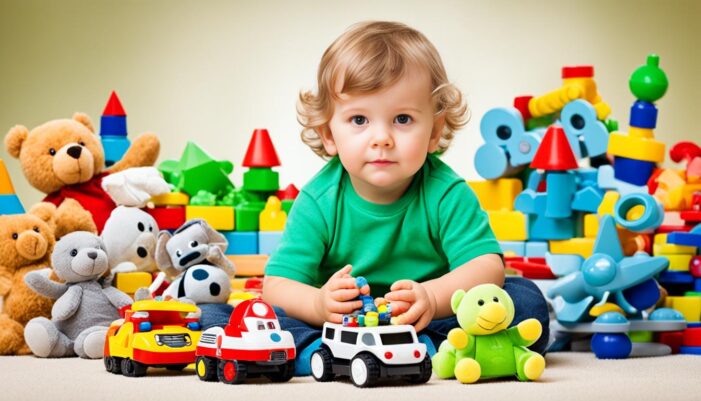Play is a crucial aspect of a child’s development, as it helps them acquire essential skills like problem-solving, creativity, and social interaction. However, as children grow older, their toy preferences and playtime behaviors evolve. Understanding these developmental changes is key to supporting a child’s growth and providing appropriate toys and activities.
This article will explore when kids typically start to outgrow toys, the stages of play, and how children’s interests and toy preferences shift over time. By gaining insights into the natural progression of a child’s toy usage, parents and caregivers can better navigate the ever-changing world of play and ensure their little ones have the resources they need to thrive.
Key Takeaways
- Play is a fundamental part of a child’s development, helping them learn and grow.
- As children age, their toy preferences and playtime behaviors change.
- Understanding these developmental shifts is crucial for providing appropriate toys and activities.
- This article will explore the stages of play and how children’s toy interests evolve over time.
- By staying informed, parents and caregivers can better support their child’s growth and adapting to their changing needs.
The Importance of Play and Developmental Milestones
Play is an integral part of a child’s development, as it allows them to learn and grow in various ways. According to child development experts, play helps children develop essential skills such as problem-solving, creativity, and social abilities. As children progress through different stages of play, they reach important developmental milestones that offer valuable insights into their growth and maturation.
Understanding Developmental Domains
These developmental milestones can be categorized into distinct “developmental domains,” which include language and communication, cognitive abilities, and physical/movement skills. By understanding these domains and the progression of play stages, parents and caregivers can better support a child’s development and recognize when a child may be ready to transition from certain toys to new ones that better align with their changing developmental toy changes and developmental play changes.
| Developmental Domain | Key Milestones |
|---|---|
| Language and Communication |
|
| Cognitive |
|
| Physical/Movement |
|
By monitoring a child’s kids’ play behavior and developmental stages and toys, parents and caregivers can better understand their children’s changing interests and toy engagement over time, enabling them to provide appropriate toys and support the transitioning from toys as the child grows and develops.
“Play is the work of childhood, and it is through play that children learn and grow.”
When Do Kids Stop Playing with Toys?
Stages of Play and Toy Preferences
The transition away from toys is a gradual process that occurs as children grow and develop. Children’s play behaviors and toy preferences change significantly over time, with distinct stages of play identified by child development experts.
During the early years, young children often engage in unoccupied play, where they seem to be observing their surroundings without a clear purpose. As they mature, they progress to solitary play, content to explore toys on their own. Over time, their interest shifts to spectator or onlooker behavior, where they observe others playing.
Around the preschool years, children begin to demonstrate parallel play, playing alongside but not necessarily with others. This gradually evolves into associative play, where children interact and share toys, though their play is still largely independent. By the time they reach the elementary school years, most children have reached the stage of cooperative play, actively engaging with peers and coordinating their play activities.
As children move through these developmental stages, their toy preferences also transform. While toddlers may be content with simple, solitary toys, older children often seek out more complex, social toys and activities. Understanding the typical timeline for these changes can help parents and caregivers provide age-appropriate toys and support a child’s ongoing development.

| Stage of Play | Age Range | Toy Preferences |
|---|---|---|
| Unoccupied Play | Infancy | Simple, sensory toys |
| Solitary Play | Toddler | Blocks, puzzles, basic pretend play |
| Spectator/Onlooker Behavior | Preschool | Toys that allow for observation of others |
| Parallel Play | Preschool | Toys that encourage side-by-side play |
| Associative Play | Preschool/Early Elementary | Toys that facilitate social interaction |
| Cooperative Play | Elementary School | Toys that promote collaboration and teamwork |
Conclusion
In conclusion, the transition away from toys is a natural part of a child’s development, as their play behaviors and interests evolve over time. By understanding the stages of play and the typical timelines for when children outgrow certain toys, parents and caregivers can better support a child’s growth and provide age-appropriate toys and activities. Staying attuned to a child’s developmental milestones and changing preferences can help ensure a smooth transition as they move away from toys and towards more complex forms of play and engagement.
As children progress through their formative years, their playtime gradually shifts from simple, object-based activities to more sophisticated forms of imaginative, social, and cognitive exploration. This evolution reflects the remarkable developmental changes that occur throughout childhood, shaping a child’s understanding of the world and their place within it. By recognizing and embracing these changes, adults can create nurturing environments that foster a child’s continued growth and learning.
Ultimately, the journey of a child’s play is a fascinating mirror of their overall development. By remaining observant and responsive to the shifting needs and interests of a growing child, parents and caregivers can ensure that a child’s playtime remains a rich, rewarding, and meaningful experience throughout their formative years.
FAQ
When do kids typically start to outgrow their toys?
The transition away from toys is a gradual process that occurs as children grow and develop. Children’s play behaviors and toy preferences change significantly over time, with six main stages of play identified: unoccupied play, solitary play, spectator/onlooker behavior, parallel play, associative play, and cooperative play. As children move through these stages, their interests and engagement with toys also evolve.
How do children’s toy preferences and playtime behaviors change as they grow older?
While young children may be content with simple, solitary play, older children often seek out more complex, social toys and activities. Understanding the stages of play and the typical timeline for when children outgrow certain toys can help parents and caregivers provide appropriate toys and support a child’s development.
What are the key developmental domains that influence a child’s play and toy preferences?
The developmental domains that influence a child’s play and toy preferences include language/communication, cognitive, and physical/movement. By understanding these developmental domains and the progression of play stages, parents and caregivers can better support a child’s growth and recognize when a child may be ready to transition from certain toys to new ones.
How can parents and caregivers support a child’s development as they transition away from toys?
By staying attuned to a child’s developmental milestones and changing preferences, parents and caregivers can help ensure a smooth transition as children move away from toys and towards more complex forms of play and engagement. Providing age-appropriate toys and activities can support a child’s growth and help them develop important skills like problem-solving, creativity, and social interaction.

